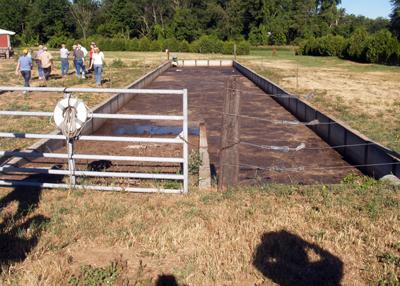Manure storage structures are an integral part of livestock feeding operations. They allow for manure containment until conditions are favorable for land application or other treatment. Manure may be stored in enclosed structures, near or directly below the animal housing facility or it may be stored in open structures such as above ground tanks or storage ponds/lagoons.
| Recommended Resources:
Archived webinar: Manure Safety & Transport Penn State Extension Manure Pit Safety Fact Sheet Series |
The risks differ for each type of manure handling system. Enclosed structures are commonly associated with asphyxiation hazards related to gases produced during manure decomposition. Open structures are most often associated with drowning. Most systems include pumps or mechanical components that present the risk of entanglement. It is critical that producers take the time to assess the risks on their operation and evaluate ways to prevent hazardous situations and to develop emergency response plans. Related: Manure Storage Safety fact sheet
Enclosed Structure Hazards
Enclosed structures, especially those located below ground, are potentially the most hazardous for people and livestock. While being stored, manure undergoes decomposition. As a result, many potentially harmful or fatal gases are produced, but most remain at low levels or are adequately diluted by the ventilation system. Situations in which these gases can become deadly include:
- Agitation of the liquid manure prior to or during pumping from the pit
- Power outage or other failure of the ventilation system
- Buildup of flammable or explosive gases
Manure Gases and Their Associated Safety Concerns
Hydrogen Sulfide

A sign like this “Danger: Liquid Manure Storage” should posted for all types of liquid manure storage, enclosed or open. Consider posting this message in other languages if there are non-English speakers living or working on or near the farm. |
Hydrogen sulfide is the greatest danger to humans in enclosed manure storage areas. It has a characteristic “rotten egg” smell and is heavier than air, so it tends to collect in the lower levels of a structure and in corners of the storage area where air circulation is least available. It quickly desensitizes the sense of smell so that a person does not detect greater levels of the gas after breathing it. It can be rapidly released when manure is agitated. At low levels (10 ppm) it can irritate the eyes. Death can occur when it reaches levels of 500 ppm or greater.
Ammonia
Ammonia has a distinctive, sharp odor and is heavier than air. It becomes irritating to humans at around 50 ppm. If it reaches levels of 1000 ppm or more, it can be deadly, although most people are so uncomfortable at this level, they usually seek relief by leaving a building before it reaches dangerous concentrations. Prolonged exposure to high ammonia levels can also impact animal performance.
Methane
Methane is a concern because it is potentially explosive at levels above 50,000 ppm. It is lighter than air and odorless. In the fall of 2009, enough manure pit-related fires and explosions were reported to attract renewed attention to the safety concerns related to gas buildup. Other potentially explosive gases produced by manure decomposition are hydrogen sulfide (H2S) and phosphine (PH3, but both become lethal to animals and humans at concentrations far below that required for ignition. A literature review by Iowa State University (supported by the Pork Board) provides additional information on this topic. Deep Pit Swine Facility Flash Fires and Explosions.
In a properly designed anaerobic digester, methane production can be enhanced and possibly captured for use in electrical generation. For more information see Introduction to Biogas and Anaerobic Digestion.
Carbon Dioxide
Carbon dioxide is odorless, but can cause asphyxiation if it displaces enough oxygen in the air. It is heavier than air and tends to accumulate in the same areas as hydrogen sulfide.
Open structure hazards
|
|
Open manure storage ponds or above ground storage tanks also pose hazards, the most obvious of which is drowning. A storage pond may form a crust on the surface that appears solid and capable of holding a person’s weight. Unfortunately, this is not always the case. Children are also at risk of drowning in these structures and safety considerations must always include ways to prevent access to these areas, such as fencing, gates with locks and outside walls on concrete structures that preclude easy entry.
To prevent drowning, it is recommended that farmers purchase and install safety measures such as life preservers or life vests, throw ropes, and/or safety harnesses (with anchor points around the structure). This equipment can save lives; not only for the victim but rescuers who can safely assist without entering the structure themselves. This was illustrated in May, 2012 in a tragic incident in Maryland. A farmer and two of his teenage sons were drowned in a manure storage structure while attempting to pump the manure out for land application. There were no surviving witnesses, but the
likely scenario is that one of the three fell into the pit and the other two died trying to rescue him.
Recommended Reading
- University of Illinois Certified Livestock Management and Commercial Manure Haulers program
- Human Illness and Disease Issues in Livestock and Poultry Production Environments
- Human Safety Issues in Livestock and Poultry Production Environments
- LPES Curriculum “Safety in Manure Storage Facilities“
- Manure Pit Safety from Pennsylvania State University contains a great deal of current information on safety hazards associated with manure storage.
Case Studies
- Manure pit injuries: Rare, deadly, and preventable
- Gypsum Bedding – Risks & Recommendations for Manure Handling
-
Two children found unresponsive (they survived) after agitation of manure pit on a farm utilizing gypsum bedding. (From archived webinar: Gypsum Bedding Risks & Rewards)
Authors: Chip Petrea, University of Illinois and Jill Heemstra University of Nebraska
Reviewers: Saqib Mukhtar, Texas AgriLife Extension; Jennifer Zwicke, USDA NRCS; Troy Chockley, USDA NRCS, Greg Martin, Penn State


